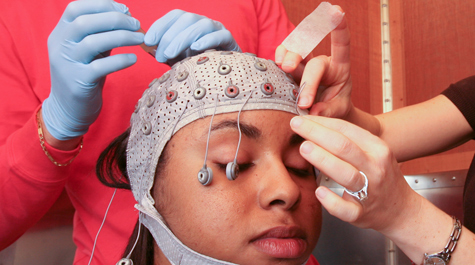Human-subject research in the age of coronavirus
The COVID-19 closings will have a substantial effect on human-subjects research at the university.
Jennifer Stevens is an associate professor in William & Mary’s Department of Psychological Sciences and chairs the university’s Protection of Human Subjects Committee (PHSC). She said she expects a number of changes in human-subjects research.
“Honestly, I don’t think people have had much of a chance to think about the long-term effects,” she said. “But for now: All on-campus, in-person lab experiments are suspended until the campus opens up to public use.”
The William & Mary campus has been closed to the general public at least through March 22. Further, researchers are to delay face-to-face interaction with research subjects until the U.S. Centers for Disease Control and the Virginia Department of Health relax their recommendations on social distancing.
The new rules are part of revised guidelines for the study of human subjects that were released on March 13 by Cynthia Corbett, manager of research compliance. The new guidelines call for the suspension of all research involving “vulnerable populations,” a group that includes, but is not limited to pregnant women, prisoners and children.
A wide range of departments at William & Mary conduct research using human subjects. “Psychological sciences is a big one, but also government, sociology, anthropology, economics,” Stevens said. “Kinesiology and health sciences is big as well.”
She explained that some human-subject research is survey-oriented and therefore does not involve direct person-to-person contact. But plenty of research at William & Mary requires close human interaction in the lab. Stevens gave the example of neurological studies that use the electroencephalogram (EEG).
"With EEG, a cap is placed tightly onto a person's scalp," she explained. “And there are electrodes. Gel goes on the electrodes to make sure there’s good contact. We ask people to brush or comb their hair and it can abrade the skin. It makes a good connection, but that's a significant exposure.”
Hygiene protocol for EEG experiments is followed rigorously, she pointed out. EEG caps are cleaned and soaked in disinfectant, even when no pandemic is brewing. EEG work and similar experiments are now prohibited. Even if more stringent protocol were adopted, conducting such research requires interpersonal contact at levels far beyond even the most conservative social-distancing COVID-19 guidelines.
Stevens noted that there are a number of courses that incorporate human-subject research. She said the best option is for researchers to consider pivoting to online work, self-studies or diary studies.
“Thesis students are probably feeling the most stressed, wondering how to accomplish their research goals,” she said. “My advice so far has been to focus on the data collection to date.”
The new guidelines state that changes in research protocol procedure during the COVID-19 emergency must be approved by the PHSC before implementation. Researchers that are foreseeing significant delays due to COVID-19 should follow PHSC procedure to clone/resubmit for successive-year approval.
















